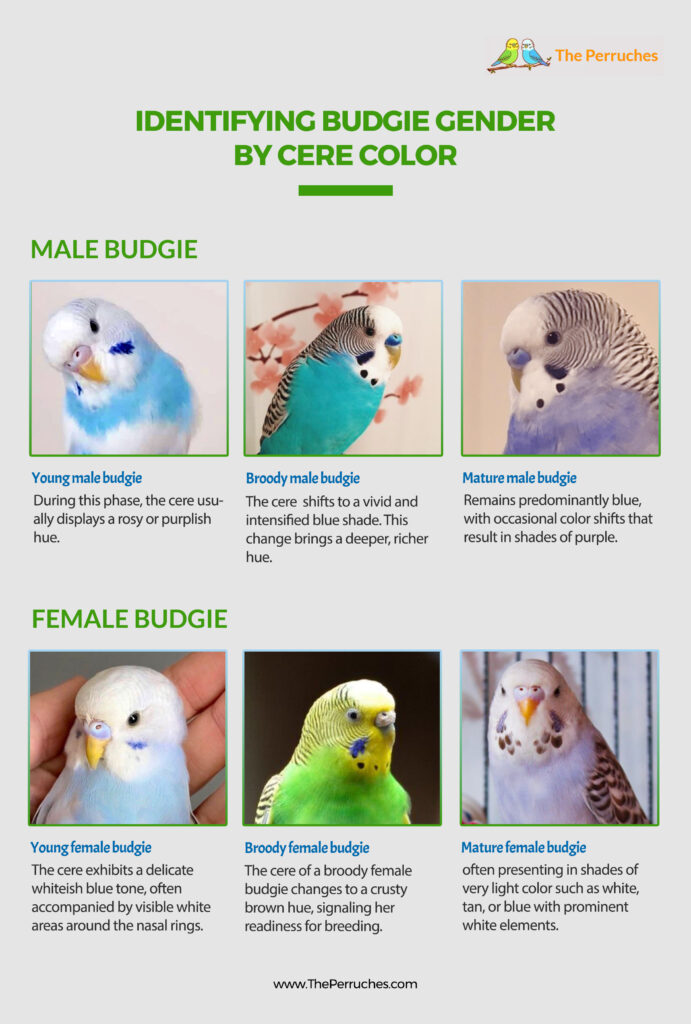Budgies, also known as parakeets, are a popular pet bird species known for their vibrant colors and playful personalities. Identifying the gender of a budgie can be challenging, especially for those who are new to keeping these birds.
However, there are a few physical characteristics and behaviors that can help determine the gender of a budgie. In this article, we will discuss the different methods of identifying the gender of a budgie.
Is My Budgie Male or Female?
One of the most common ways to determine your budgie’s gender is by observing the color of its cere, the area just above the beak. In mature males, the cere is typically blue, while in mature females, it’s usually brown.
Main Differences Between Male and Female Budgies
Here are the key differences between male and female budgies:
- Cere Color: The most common and reliable difference is the color of the cere. Males typically have a blue or purplish cere, while females have a brown or tan cere. This distinction becomes most apparent in mature birds.
- Vocalization: Male budgies are often more vocal and prone to mimicry. They tend to have a wider range of sounds and tunes in their repertoire. Females, on the other hand, are generally quieter and less inclined to imitate noises.
- Feather Patterns: Males may display more vibrant and pronounced feather patterns, with brighter colors. Female budgies often have smoother and subtler feathering.
- Behavioral Traits: While not a definitive difference, males can sometimes exhibit more active and outgoing behaviors, while females might be calmer and more reserved.
Remember that individual budgies can have unique personalities regardless of their gender, so it’s important to consider a combination of characteristics for accurate identification.
Visual Identification
Determining the gender of your parakeet birds, often referred to as parakeet sexing, is a common inquiry for bird enthusiasts and pet owners. Fortunately, there is a reliable method that involves observing a distinctive part of their anatomy – the cere.

The budgie gender cere chart provides an easy way to identify the gender of your budgie at different ages. By comparing the color and development of the cere, owners can accurately distinguish between male and female budgies from a young age.
For example, young male budgies typically have a pink or purplish cere that gradually turns blue as they mature, while female budgies start with a pale blue or white cere that becomes tan or brown. Using the cere chart can simplify the process of budgie gender identification, ensuring that pet owners can confidently determine the sex of their feathered friends.
Another visual cue is the color of the feathers. Male budgies tend to have brighter and more vibrant colors than females. However, this is not always the case and other factors such as diet and lighting can also affect feather color.
The size of the budgie can also provide a clue as to its gender. Male budgies tend to be slightly larger than females, but this difference can be hard to spot.
Behavioral Identification
Another way to identify the gender of a budgie is by observing its behavior. Male budgies tend to be more vocal and aggressive than females. They are also known to perform courtship displays, such as puffing up their feathers and swaying their head back and forth.
Female budgies also tend to be less aggressive and more docile than males. They are also less likely to perform courtship displays. However, it’s important to note that individual birds may not conform to typical gender-based behaviors, and some females may be more vocal or aggressive than others.
DNA Testing
The most accurate method of identifying the gender of a budgie is through DNA testing. This method involves taking a small sample of blood or feather and sending it to a laboratory for analysis. The results of the test will indicate the gender of the bird with a high degree of accuracy. This method is particularly useful for breeders and pet store owners who need to know the gender of their birds for breeding or sale purposes.
Conclusion
It’s important to remember that individual birds may not conform to typical gender-based characteristics, and that some males may be less vocal or less colorful than others. If you’re unsure about the gender of your bird, it’s best to consult with an avian veterinarian for guidance.

